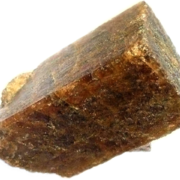Andalusite: Properties, Uses and Virtues
Andalusite: The Color-Changing Gem
Andalusite, a captivating gem known for its remarkable play of colors, has a history as rich and diverse as its hues. Believed to carry transformative energies, andalusite has been revered across cultures for its unique properties. In this exploration, we delve into the geological formation, historical legacy and mystique surrounding this extraordinary gem.
- Andalusite Geological Formation
- Rough Andalusite Crystal
- Sources – Andalusite’s Worldwide Reach
- Historical Significance of Andalusite – Through the Ages
- Metaphysical properties of Andalusite – Illuminating energies
- Andalusite Varieties
- Andalusite Colors
- Durability and Wearability of Andalusite
- Andalusite Enhancements – Preserving Natural Beauty
- Synthetic Andalusite – La Nature en Laboratoire
- Imitations of Andalusite – Discerning the Authentic
- Andalusite Care – Preserving natural beauty
Andalusite Geological Formation
Andalusite is a mineral formed under high-pressure metamorphic conditions. Originating from minerals such as cyanite and sillimanite, andalusite is created in the earth’s crust through the transformation of existing minerals. This complex process gives rise to the gem’s remarkable play of colors and unique attributes.
In the case of chiastolite, black inclusions get trapped in the process, creating that distinctive visual.
Rough Andalusite Crystal
Raw andalusite crystals are generally found in pebble form. They showcase the gem’s amazing ability to change color depending on the angle of observation. Viewed from different angles, the gem changes between shades of green, brown and reddish-brown. This phenomenon, known as pleochroism, adds an extra layer of fascination to andalusite, as its colors dance and change with the light.
Sources – Andalusite’s Worldwide Reach
Andalusite’s worldwide presence bears witness to its captivating appeal. Found in diverse regions such as Brazil, Sri Lanka, France and Spain, each place contributes its own variations of andalusite, presenting a captivating range of colors and qualities.
Historical Significance of Andalusite – Through the Ages
In regions where andalusite was naturally abundant, such as Spain and Sri Lanka, the gemstone was of cultural importance.
In Spain, Andalusite was named after the region of Andalusia, reflecting its strong association with the region’s cultural heritage. The gemstone’s unique color-changing properties were often linked to the changing landscapes and moods of the region.
Modern jewelry designers and gem enthusiasts continue to appreciate andalusite for its unique beauty and ability to reflect the ever-changing nature of life. The gemstone’s historic heritage continues to inspire new generations to explore its remarkable qualities.
Metaphysical properties of Andalusite – Illuminating energies
Andalusite is revered for its metaphysical attributes, believed to facilitate personal transformation and growth.
It is considered a stone of balance, encouraging harmony between the physical, mental and spiritual planes.
Those drawn to Andalusite seek its energies to gracefully navigate through life’s changes, embracing the potential for spiritual evolution.
Andalusite Varieties
Andalusite comes in a variety of forms, each with its own distinct characteristics.
- Classic” andalusite: green to reddish-brown. Very exceptionally pink to blue.
- Chiastolite: a grayish, translucent variety with a distinctive cross-shaped pattern of black inclusions.
- Dark green andalusite: Medium to dark green, these stones can also be called Viridine.
Andalusite Colors
Andalusite’s captivating colors range from earthy green to warm browns and deep reddish browns. Brazilian deep-green andalusite may be called Viridine.
Exceptionally, pink and blue andalusite can also be found. The changing shades of andalusite add intrigue to jewelry designs and captivate the eyes of admirers.
Durability and Wearability of Andalusite
With a hardness of 7 to 7.5 on the Mohs scale, andalusite is remarkably durable. Its robust nature makes it a suitable option for many different types of jewelry, from rings to pendants. This gem’s endurance allows wearers to embrace its beauty without fear of easy damage.
Andalusite Enhancements – Preserving Natural Beauty
This gemstone is usually presented untreated. In exceptional cases, heat treatment can be applied.
Synthetic Andalusite – La Nature en Laboratoire
Synthetic andalusite exists for research purposes but has not yet been used in jewelry.
Imitations of Andalusite – Discerning the Authentic
The appeal of andalusite can lead to imitations, so it’s essential that buyers remain vigilant. Glass imitations, tourmaline and tinted stones can resemble andalusite, so it’s crucial to acquire gemstones from reputable sources.
Andalusite Care – Preserving natural beauty
Taking care of andalusite jewelry is essential to preserve its appeal. Avoid exposure to aggressive chemicals and sudden temperature changes. Gently clean the gemstone with mild soapy water and a soft brush. Storing andalusite jewelry separately from other gemstones avoids potential scratches.


